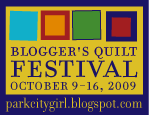These are the successes. I have long admired the look of fabric dyed with potato dextrin resist. I purchased some potato dextrin a while ago, but I hadn't tried it. My first attempts were disasters. I used the (rather expensive) potato dextrin that I purchased online and the recipe from Ann Johnston (here).
 |
| The left side (black) is the first try that worked, the blue is the second pass. (Ignore the black blobs in the middle and along the edge of the first side.) |
 |
| This was with the old dyes and gooey potato starch resist |
The reason it didn't work is cooking 101 (or maybe 201). Potato starch molecules are encased in stuff like little pillows and if you beat the potatoes too hard (like with a power mixer), you break up the little pillows and end up with a gluey mess. Sometimes you get a sticky mess instead of fluffy mashed potatoes; this stuff works the same way.
So I went to the store and purchased two boxes of instant potato flakes. I bought the (much cheaper) store brand and a box of a national brand. They are pretty much identical for this purpose. The only difference I could find was that the cheaper stuff didn't have the fancy inner liner. Big deal...not.
I mixed it up sort of following the recipe in Complex Cloth by Jane Dunnewold. I did make some changes, so I'm going to include my recipe at the end. Then I let it cool and spread it on the fabric (I reused the same fabric I had used for the first couple of experiments). I let it dry.
 |
| This is what the starch looks like after it has been dried and distressed. |
No, I didn't stretch it out -- in fact, I got much quicker results by draping it over some empty plastic lettuce boxes. It didn't need to be flat because I was going to roll and flatten it so the starch would break up and allow space for the dye to seep in.
 |
| Too much thickened dye -- looks like a tar pit. |
 |
| The result of too much dye -- blobs! |
 |
| Thin layer of starch with dye painted over |
I let it batch, then soaked it in a bucket of warm water for a couple of hours to dissolve the potato. I did have to scrunch and swish it a bit to get rid of the starch. Then I washed it as usual for hand-dyed fabric.
This bottom photo is the back of the fabric after I spread the dye over the potato starch.
I have left the photos fairly large, so click on them to examine them more closely.
Potato-starch Resist (adapted from Complex Cloth)
This recipe can be doubled or quadrupled. I was able to cover about half a yard of fabric with this amount.
2 3/4 cups water
1 cup instant mashed potato flakes
1 1/2 Tablespoons of liquid starch (the stuff in the laundry section of the grocery store)
Bring the water to boil in a large saucepan. Add the potato flakes and turn heat down to medium or low. Cook, stirring by hand with a large spoon, for 5 minutes. Remove from heat, transfer from your kitchen pot to a small bucket (I use paint containers from my local hardware store). Return your pot and spoon to the kitchen. Add liquid starch to the bucket, stirring by hand with a large whisk (do NOT use this whisk in your kitchen anymore after it's been used for art work). The mixture should be very smooth. Let the mixture cool, then spread it on the fabric. I put a piece of plastic wrap on the potatoes while they cool so that they don't dry out and get crusty on top. I used wide plastic putty knives to spread the starch. The thinner the layer of resist, the finer the network of lines you will get with the dye.
If there is interest -- I can discuss the process and use of thickened dyes sometime.
Oh -- and for dinner, I use a ricer to mash my potatoes (and garlic) after they're boiled; then I use a hand whisk to fluff them. Add some hot milk or sour cream and perfection! Light, fluffy mashed potatoes. Mmmmm.






























5 comments:
OMGosh....that last piece of fabric makes all the experiments worth it! Beautiful!!!
I always wanted to try this but was too much of a tightwad to buy the dextrin.
However......I always have cheap boxed mashed potatoes! >:-)
XXOO~~♥
Anne
Thanks for sharing your good and bad of a technique! HA Interesting post for sure! Thanks again!
Hummmm so does this mean you will be experimenting with Flour paste resist next. Much more convenient than keeping instant potatos on hand!
Learning what NOT to do/ what does not work, is just as important as the successes........it really is all about the process and discovery isn't it?
I LOVE to play and see what happens......but I think I might have just eaten the potatoes.... I mean I really like potatoes :-)
I tried this last summer using Jane Dunnewold's recipe, and found the fabric was really stiff even after washing it twice. The one thing that really bothered me is that instant mashed potatoes are considered "food"--after making them for the first time for this fabric experiment, I realized how gross they would be to actually eat. Yuck.
Post a Comment